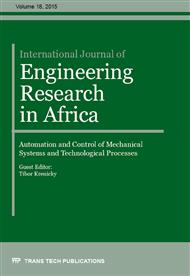[1]
J. Dostrovsky, H. Bergman, Oscillatory activity in the basal ganglia—relationship to normal physiology and pathophysiology, Brain 127/4 (2004) 721-722.
DOI: 10.1093/brain/awh164
Google Scholar
[2]
M. Alegre, M. Valencia, Oscillatory activity in the human basal ganglia: More than just beta, more than just Parkinson's disease, Experimental neurology 248 (2013) 183-186.
DOI: 10.1016/j.expneurol.2013.05.018
Google Scholar
[3]
C.M. Davidson, A.M. de Paor, M.M. Lowery, Control theory and deep brain stimulation for relief from neurological diseases, Acta Mechanica Slovaca 17 (2013) 22-30.
DOI: 10.21496/ams.2013.042
Google Scholar
[4]
N. Ray et al., Local field potential beta activity in the subthalamic nucleus of patients with Parkinson's disease is associated with improvements in bradykinesia after dopamine and deep brain stimulation, Experimental neurology 213/1 (2008).
DOI: 10.1016/j.expneurol.2008.05.008
Google Scholar
[5]
A.M. de Paor, M.M. Lowery, Analysis of the mechanism of action of deep brain stimulation using the concepts of dither injection and the equivalent nonlinearity, IEEE Transactions on Biomedical Engineering 56/11 (2009) 2717-2720.
DOI: 10.1109/tbme.2009.2019962
Google Scholar
[6]
P.L. Nunez, The brain wave equation: a model for the EEG, Mathematical Biosciences 21/3 (1974) 279-297.
DOI: 10.1016/0025-5564(74)90020-0
Google Scholar
[7]
M.D. Johnson et al., Mechanisms and targets of deep brain stimulation in movement disorders, Neurotherapeutics 5/2 (2008) 294-308.
Google Scholar
[8]
T. Wichmann, M.R. DeLong, Deep-brain stimulation for basal ganglia disorders, Basal ganglia 1/2 (2011) 65-77.
DOI: 10.1016/j.baga.2011.05.001
Google Scholar
[9]
O.I. Elgerd, Control systems theory, McGraw-Hill, New York, (1967).
Google Scholar
[10]
H.M. Power, R.J. Simpson, Introduction to dynamics and control, McGraw-Hill, UK, (1978).
Google Scholar
[11]
E. Ryapolova-Webb et al., Chronic cortical and electromyographic recordings from a fully implantable device: preclinical experience in a nonhuman primate, Journal of neural engineering 11/1 (2014) 016009.
DOI: 10.1088/1741-2560/11/1/016009
Google Scholar
[12]
F.L. da Silva et al., Models of neuronal populations: the basic mechanisms of rhythmicity, Progress in brain research 45 (1976) 281-308.
DOI: 10.1016/s0079-6123(08)60995-4
Google Scholar


